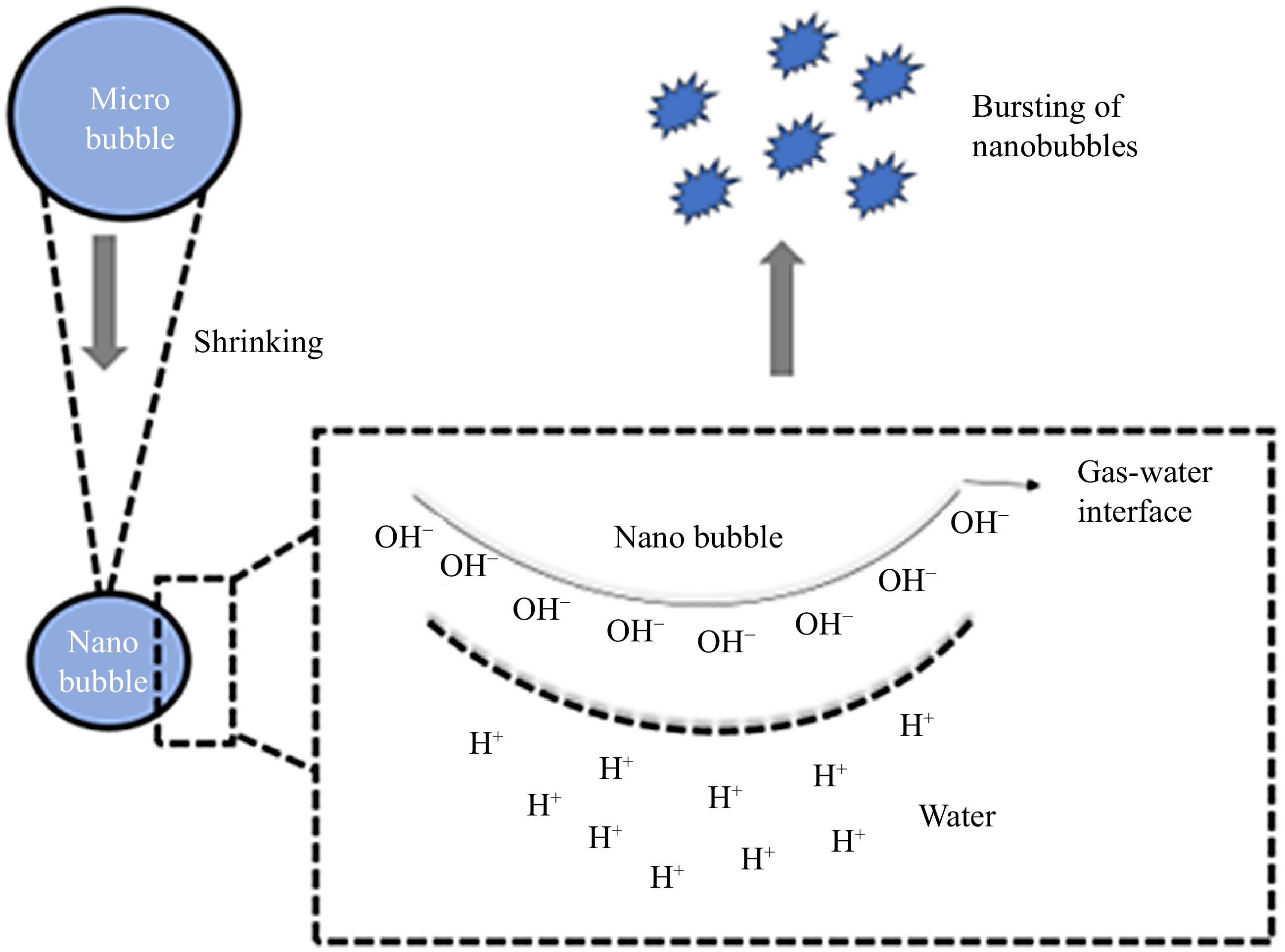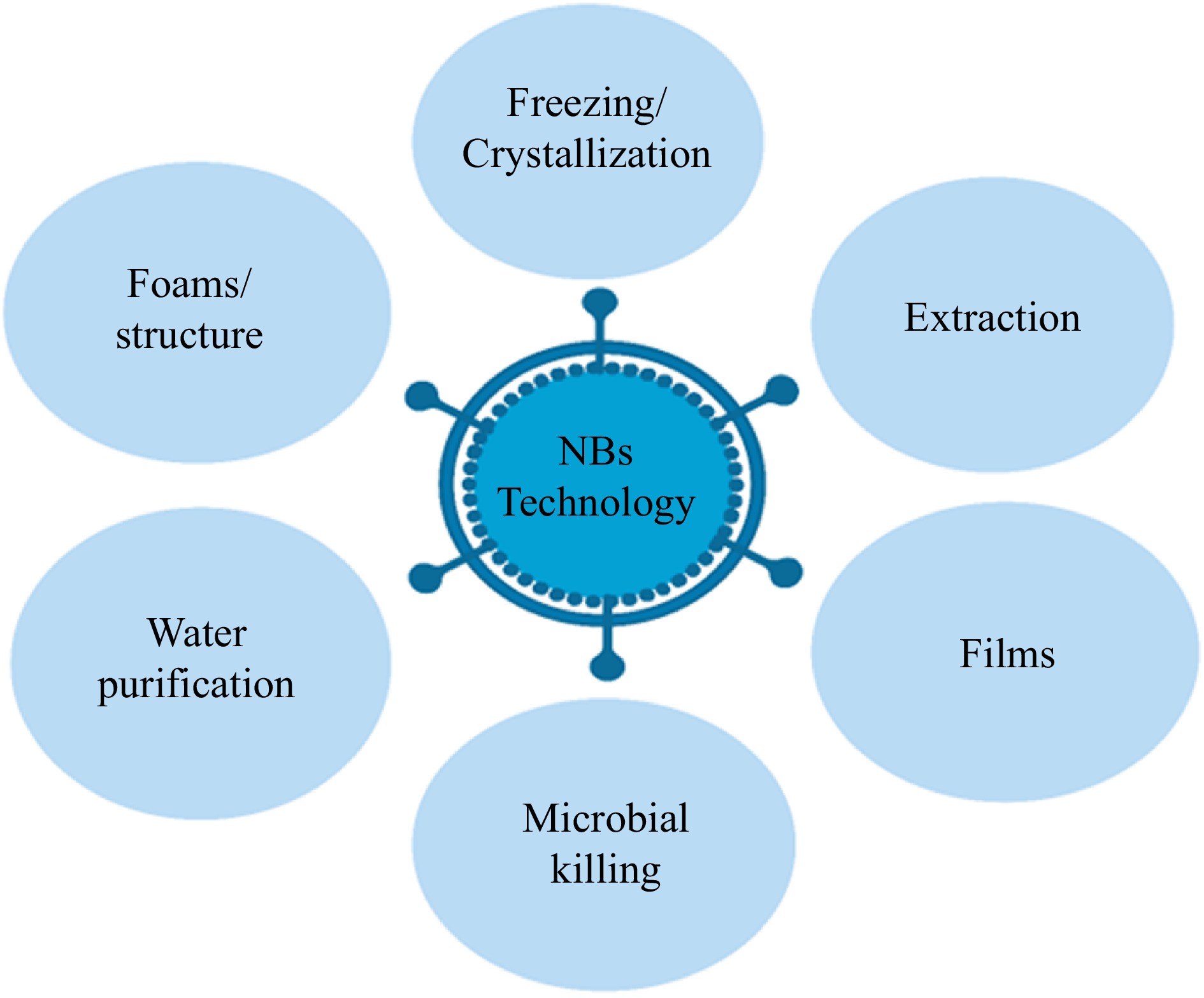-

Figure 1.
Conversion of microbubbles to nanobubbles formation with a high negative charge.
-

Figure 2.
Methods of nanobubble generation.
-

Figure 3.
Application of nanobubble technology in food and beverages.
-

Figure 4.
Mechanism of nanobubbles action in different applications.
-
Sample NBs method
(alone or coupled)Process mechanism Process parameters Process efficiency References Camellia oleifera shells Coupled with ultra-sonication Nano jet formation Rhamnolipid concentration (5 CMC), time (16 min) Efficient green method for extraction [16] Carya cathayensis Sarg (Walnut shells) Coupled with ionic
liquid solutionIonic liquid Nano jets formation Ionic liquid concentration (1 M), time (9 min), temperature (30 °C) Showed better extraction of phenolic compounds than ethanolic [12] Mustard Alone Air and O2 NBs generated through nano bubble aerator Cavitation time (30 min), pump speed (3,600 rpm) Weight increased by 35% [13] Tomato Coupled with micro
bubble technologyAir NBs injection method Air NBs concentration
(15 and 25 mg/L)Improved tomato yield and enhanced vitamin C and lycopene content [77] Cucumber Coupled with micro
bubble technologyAir NBs injection Air NBs concentration
(15 and 25 mg/L)Improved cucumber yield [77] Maize Coupled with micro
bubble oxygenation
technologyGas liquid mixing O2 NBs concentration
(10, 20, and 30 mg/L)Yield increased up to 11.7% [78] Sugarcane Coupled with micro
bubble water technologyPasteurization MNBs water (1:0 and 1:4) Increased soil fertility and yield increased up to 17.6% [79] Barley Coupled with low-concentration H2O2 NBs Water stimulated the expression of genes involved in cell division and cell wall thinning NBs generation time
(60 min)Germination rate increased up to 25% [80] Camellia oleifera shells Coupled with ultra-sonication Green extraction methods crucial for efficient and safe extraction Tween 80 and rhamnolipid NBs concentration (5 CMC), time 16 min) Increased total phenolic and flavonoid content [58] Carrots and fava beans Alone Compression and decompression method NBs generator pressure (414 KPa), time (90 min), flow (0.4 L/m) Increased seed germination rate [9] Chinese cabbage Couple with micro
bubble technologyOstwald ripening Electrolyzed solution
(50 mg/L) and NBs
solution (50 ppm), pH 4.0Enhanced microbial cleaning [81] Instant coffee Coupled with spray
freeze dryingStable NBs foams Pressure (588.39 KPa),
flow rate (6 mL/min)Outstanding foam stability and unbroken foam surface [18] Apple Juice concentrate Alone CO2 NBs influence
on juice on viscosityNBs pressure (300 Kpa), time (5, 13, 26 min), temperature (23 °C) Significant reduction in viscosity [82] Ice cream Coupled with micro
bubble technologyEffect of CO2 NBs on physicochemical properties NBs concentration (2,000 ppm), temperature
(5 °C), time (1 min)Enhanced the sensory and physicochemical prope [83] Milk Coupled with spray
dryingNano bubbles helped
to produce milk via
non-aggregationAir NBs flow rate
(0.3 L/min)Enhanced process efficiency and reduced viscosity [84] Apple Coupled with micro
bubble technologyOzone MNBs for removing pesticide residue MNBs pressure (0.5 MPa) Improved residual removal efficiency [85] Eggs (without
shells and boiled)Coupled with micro
bubble technologyFood seasoning N/A Improved liquid seasoning permeation [86] Protein (hydrophobin) Alone Supporting in protein purification Purity improved by 2.8 times [68] Table 1.
Nanobubble applications in food products.
Figures
(4)
Tables
(1)